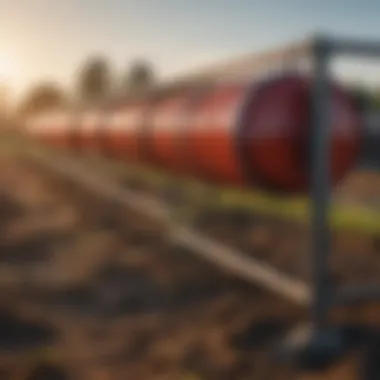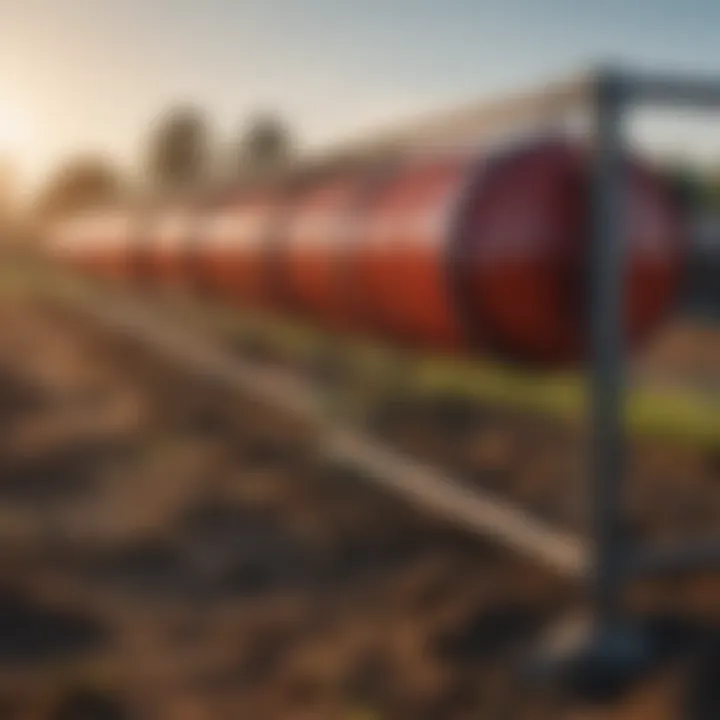Understanding Tube Heaters: Applications and Innovations


Topic Overview
Definition and Importance
Tube heaters, commonly known for their efficient heating capabilities, are long, cylindrical heating solutions often used in various speculative environments. They operate by circulating hot air or infrared heat, which effectively warms up the surrounding area. Their significance cannot be understated, particularly in areas like agriculture and horticulture where temperature control is critical for crop yield and quality. Tube heaters provide uniform warmth and can operate in challenging conditions, making them an essential tool for farmers and greenhouse operators alike.
Brief History and Evolution
The evolution of tube heaters is intertwined with advancements in heating technology. Originally, traditional heating methods, such as open flames or conventional electric heaters, dominated the market. Their inefficiencies and safety concerns paved the path for the development of more sophisticated heating solutions. Today, tube heaters leverage both electricity and gas, adapting to various power sources and enhancing energy efficiency. Over time, innovations have introduced features such as programmable thermostats and smart controls, further refining their use in precision farming.
Key Techniques and Innovations
Sustainable Farming Practices
Sustainability in agriculture increasingly necessitates energy-efficient solutions. Tube heaters fit perfectly into this narrative. Unlike traditional methods that waste heat, these heaters focus thermal energy precisely where it's needed, minimizing heat loss. This efficiency not only lowers operational costs but also aligns with environmentally friendly practices. Landscaping and floriculture sectors extensively use tube heaters to maintain optimal temperatures in wheel or tunnel greenhouses.
Advanced Agronomic Technologies
Recent advancements have led to the integration of technology within tube heaters. Modern systems can now connect to smart sensors that monitor environmental conditions in real time. Such innovations facilitate automatic adjustments, ensuring that the heating levels remain optimal for plant growth. This data-driven approach enhances agricultural productivity by providing farmers with actionable insights into their heating requirements, resulting in better management of resources.
Practical Applications
Step-by-Step Guides
Implementing tube heaters in agricultural settings involves a clear strategy. Start by assessing the specific heating needs based on crop type and growing conditions. Next, select the appropriate heater model, considering factors such as heating capacity and energy source. Installation should follow manufacturers' guidelines, ensuring safety and efficiency. Once operational, it is crucial to monitor performance regularly, adjusting settings as needed to adapt to changing environmental conditions.
Case Studies or Real-World Examples
For instance, a greenhouse vegetable farm in California adopted tube heaters and saw a 30% reduction in heating costs over a winter season. By shifting from traditional heating methods to tube heating, they maintained consistent temperatures and improved crop quality. Another example can be seen in floriculture; a flower nursery using tube heaters reported not only enhanced plant growth but also extended the growing season.
Tube heaters represent an intersection of technology and agricultural efficiency, paving the way for sustainable farming practices that are essential in today's climate.
Prolusion to Tube Heaters
The relevance of tube heaters in modern heating solutions cannot be understated. With their unique design and efficiency, tube heaters serve a crucial role especially in environments demanding consistent and effective heating. These heaters not only cater to agricultural needs but also influence how spaces are configured and maintained. Understanding how tube heaters function can guide farmers and enthusiasts in selecting optimal heating solutions, thus ensuring their investments yield satisfactory returns.
Defining Tube Heaters
Tube heaters are a form of radiant heating technology. They consist of long, cylindrical tubes, usually filled with gas or liquid, which heat up and radiate warmth into the environment. This direct heating mechanism differs significantly from conventional heating systems like forced air, which relies on the circulation of air. Tube heaters can be found in various designs, including those that can be wall-mounted or suspended from the ceiling. This versatility makes them effective in both small and large spaces.
History of Use
The emergence of tube heaters dates back several decades, with their origin rooted in the need for more efficient heating solutions. Over time, as energy costs surged, the demand for systems offering better heat retention and distribution grew. In agriculture, for instance, they have become invaluable in greenhouse setups, where controlling temperature is essential for crop growth. The continuous evolution of these heaters has led to improvements in design and material, enhancing efficiency and longevity. Today, they are widely recognized for their effectiveness and are now a staple in many agricultural applications.
Mechanics of Tube Heaters
The mechanics of tube heaters play a crucial role in understanding their functionality and effectiveness. Tube heaters serve as a compelling alternative to traditional heating methods due to their unique design and operational principles. With a focus on how these heaters work and their essential components, it becomes clear why they are increasingly favored in various applications, particularly in agriculture.
How Tube Heaters Work
Tube heaters primarily operate by circulating warm air through elongated tubes. This process is often accomplished through either convection or conduction methods, depending on the specific design and application of the heater. The heating element within the tube warms up, releasing heat into the surrounding area.
One of the key advantages of this design is the efficiency with which heat is distributed. Because the heat is released evenly along the length of the tube, it minimizes cold spots and optimizes temperature regulation in the space being heated.
Additionally, tube heaters can be configured to operate on different energy sources, such as electricity or gas. This flexibility allows farmers to select an option that best suits their operational needs and energy availability. The energy efficiency of tube heaters is notable; they require less energy to achieve desired temperatures, making them a cost-effective solution in the long run.
Components of Tube Heaters
Understanding the components of tube heaters is important for both effective operation and maintenance. The basic elements typically include:
- Heating Element: Often made of high-quality metals, it is the core of the heating mechanism.
- Aluminum Tubes: These are lightweight and aid in efficient heat transfer. Their conductive properties are crucial for performance.
- Control Systems: Advanced models may include smart controls that allow for temperature regulation and integration with other systems.
- Insulation: Quality insulation is essential to prevent heat loss, enhancing energy efficiency.
The overall design of these components ensures not only effective heating but also durable performance. Proper knowledge of these elements enables users to undertake necessary maintenance and make informed decisions regarding upgrades or replacements as technology improves.
"The functionality of tube heaters hinges not only on their operational mechanics but also on the materials and technology used in their components."
In summary, the mechanics of tube heaters illuminate their practical benefits in agricultural and horticultural contexts. Understanding how they operate and their constituent parts empowers users to optimize their heating solutions, leading to improved productivity and efficiency.
Applications in Agriculture
Applications in agriculture highlight the critical role tube heaters play in enhancing productivity and maintaining the optimal environment for crops and livestock. These heating solutions have become increasingly essential in modern agricultural practices, where efficiency and effective climate control are vital for success.
Heating Greenhouses
Greenhouses depend on stable temperature levels to promote healthy plant growth. Tube heaters are an effective solution for maintaining suitable conditions within these structures. They offer several benefits:
- Uniform Heat Distribution: Unlike traditional heating methods, which may lead to hot spots and cold corners, tube heaters deliver heat evenly across the entire space. This uniformity prevents temperature fluctuations that can stress plants and hinder growth.
- Energy Efficiency: Many tube heaters are designed to operate on lower energy consumption. They heat up quickly and maintain warmth, which translates into reduced energy bills for greenhouse operators. This is particularly important in larger setups, where heating costs can significantly impact overall profitability.
- Versatile Temperature Control: Farmers can adjust the output of tube heaters to suit the specific requirements of different crops. This adaptability helps maximize yield potential across various plant species, from delicate seedlings to mature vegetables.
In practical terms, tube heaters can be installed along the sides of the greenhouse or suspended from the ceiling, ensuring minimal disruption to available space. This flexibility allows growers to maximize their growing area and utilize every square foot effectively.
Livestock Heating Solutions
Keeping livestock warm during colder months is essential for maintaining health and productivity. Tube heaters provide targeted heating solutions that benefit various types of animals, from cattle to poultry. Their advantages include:
- Localized Heating: Tube heaters can be strategically placed in areas where animals congregate, providing warmth directly to where it is needed most. This setup reduces the energy wasted on heating unoccupied spaces.
- Improved Animal Welfare: Ensuring a comfortable environment for livestock helps prevent stress-related issues and improves overall animal health. Warm, draft-free areas allow animals to maintain body heat, leading to better feeding and growth rates.
- Cost-Effective Solutions: By reducing heating costs through efficient operation, tube heaters can contribute to a more sustainable approach for livestock management. This economic consideration is key for farmers looking to enhance their bottom line without compromising animal welfare.
Benefits of Tube Heaters
The significance of tube heaters lies in their ability to offer distinct advantages that cater to the specific heating needs of diverse applications. In agriculture, the efficient heating of greenhouses and livestock areas influences not only operational costs but also overall productivity. Understanding the unique benefits of tube heaters helps farmers and agricultural professionals make informed choices about their heating systems.


Energy Efficiency
One of the primary benefits of tube heaters is their energy efficiency. Unlike conventional heating methods that can lose heat through walls and ceilings, tube heaters are designed to radiate heat directly into the space being heated. This design minimizes heat loss and ensures that energy usage is optimized.
- Lower Energy Bills: With effective heat distribution, tube heaters can significantly reduce heating costs compared to traditional systems.
- Temperature Consistency: They maintain a stable temperature, which is vital for both crops and livestock, ensuring balanced conditions that promote growth and well-being.
Research indicates that using tube heaters can result in energy savings of up to 30% in comparison with other heating systems. This efficiency can lead to a swift return on investment, reinforcing why many farmers turn to this technology.
Space Saving Design
Tube heaters are also celebrated for their compact design. They can be installed in narrow spaces such as along walls or ceilings, freeing up valuable floor area for other activities.
- Maximized Space: Especially in greenhouses, where every square foot counts, their slim profile allows growers to utilize the remaining space for more plants or expansion of operations.
- Flexibility in Installation: This flexibility permits installation in various configurations, enabling farmers to create effective heating zones tailored to their specific needs.
Additionally, the unobtrusive nature of these heaters enhances the aesthetic of the spaces they occupy, making them a practical choice for many environments.
Versatility
The versatility of tube heaters further contributes to their appeal. Their applications span various sectors, including agriculture, horticulture, and even commercial settings.
- Multiple Applications: From heating greenhouses to ensuring warm conditions for livestock, tube heaters can be adapted to fit numerous contexts.
- Integration with Other Systems: They can work in conjunction with existing HVAC systems, adding another layer of efficiency and functionality to heating solutions.
Their capability to operate with different power sources, such as electricity or gas, further enhances their flexibility, allowing users to select the most appropriate energy source for their circumstances.
In summary, tube heaters offer a combination of energy efficiency, space-saving design, and versatility that makes them a wise choice for modern agricultural heating solutions.
Each of these benefits contributes to the overall efficiency and cost-effectiveness, leading to improved agricultural practices and enhanced productivity.
By understanding these advantages, farmers can better assess how tube heaters fit into their operations, ensuring they are making choices that align with their goals.
Comparing Tube Heaters to Conventional Heating Systems
In the context of heating solutions, comparing tube heaters to conventional systems is crucial for informed decision-making. Tube heaters provide a unique range of benefits that can enhance efficiency and effectiveness in various applications, particularly within agriculture. Understanding these differences helps users to select the most suitable heating option for their unique needs.
Heat Distribution
One of the primary advantages of tube heaters is their superior heat distribution capabilities. Unlike traditional systems that may radiate heat unevenly, tube heaters use radiant heat technology. This method allows for even dispersion of warmth across a specified area.
- Even Heating: Tube heaters warm the objects in the environment instead of the air alone. This results in maintaining higher temperatures at the surface level, which is particularly important in agricultural settings.
- Targeted Heating: Growers can position tube heaters strategically to focus on specific areas, such as plant rows or livestock shelters. This specificity helps in lowering energy use while maximizing heat output in critical zones.
- Reduced Heat Loss: Conventional systems often lose heat through ventilation or drafts. The design of tube heaters minimizes these losses. The results are fewer fluctuations in temperature and enhanced comfort for plants and animals alike.
The benefits of improved heat distribution seen in tube heaters can significantly influence the overall heating efficiency of structures like greenhouses or barns.
Cost Analysis
Cost effectiveness remains a fundamental consideration for choosing a heating system. Tube heaters may have higher initial costs; however, they can lead to substantial savings over time. Here are some essential points for consideration:
- Lower Energy Costs: Tube heaters typically operate more efficiently than conventional heating systems. Their focused design reduces energy consumption, which leads to reduced monthly bills.
- Long Lifespan: The durability of tube heaters translates into a longer lifespan compared to traditional heating units. This longevity means fewer replacement costs, which is vital for budget-conscious farmers.
- Maintenance Expenses: Conventional systems often require more frequent maintenance due to the complexity of their parts. Tube heaters, in contrast, feature simpler components that are easier to maintain. This results in lower maintenance costs over time.
Consider the following when assessing potential long-term savings:
- Initial investment vs. long-term savings
- Energy prices fluctuations
- Maintenance costs and replacement intervals
"Investing in tube heaters results not only in improved agricultural output but also in financial efficiency, especially in the long run."
Installation Considerations
Installing tube heaters is a significant step that can greatly influence their efficiency and long-term performance. Proper installation ensures optimal function and safety. Without appropriate planning and execution, both the devices and the environment they serve can be at a disadvantage. Thus, understanding installation considerations is critical for users.
Site Assessment
Site assessment is the first part of the installation process. It involves evaluating the physical space where the tube heaters will be placed. Key factors to consider include:
- Space Layout: The dimensions of the area are crucial. Knowing the height and width allows for the appropriate choice and layout of tube heaters.
- Heat Requirements: Each environment will have specific heating needs. In a greenhouse, for example, identifying zones with varying heating requirements ensures optimal placement.
- Obstacles: Columns, ventilation openings, and existing electrical setups can affect heater placement. Identifying these is key to preventing air blockages and efficiency loss.
- Safety Regulations: Review any local building codes and regulations that apply to heater installation. Compliance with regulations avoids potential fines and ensures safety.
A thorough site assessment can improve heater efficiency significantly.
Professional vs. DIY Installation
The choice between professional installation and doing it yourself (DIY) is often debated. Both options have their advantages and disadvantages.
Professional Installation:
Engaging a professional offers several benefits:
- Expertise: Professionals possess the skills and experience needed to install tube heaters efficiently and safely.
- Time-Saving: Their knowledge allows for a quicker setup, minimizing downtime.
- Warranty Compliance: Many manufacturers require professional installation for warranty coverage, protecting the investment.
DIY Installation:
On the other hand, some prefer DIY for these reasons:
- Cost-Effective: It eliminates labor costs and can be more budget-friendly.
- Personal Satisfaction: Completing a project can provide a sense of achievement.
- Flexibility: DIY allows for adjustments during installation based on personal preferences or insights.
However, DIY installation carries risks. Lack of experience can lead to improper installation that might diminish efficiency or create safety hazards. In summary, weighing both sides will help the user find the best fit for their needs.
"The choice between professional installation and DIY often depends on expertise, budget, and the specific requirements of the heating setup."
Maintenance and Safety
Maintaining tube heaters is crucial in ensuring they operate efficiently and safely over time. This section outlines routine maintenance tasks as well as vital safety protocols that should always be observed when using these heating systems. Proper maintenance not only prolongs the life of the equipment but also enhances energy efficiency and minimizes the risk of malfunctions or accidents.
Routine Maintenance Tasks
Routine maintenance is an essential practice for anyone using tube heaters. Regular checks and servicing can prevent costly repairs and ensure optimal functionality. Here are some key maintenance tasks to consider:
- Visual Inspections: Regularly inspect the heater for signs of wear, corrosion, or any unusual physical conditions. Look for cracks or loose fittings that may develop over time.
- Cleaning: Dust and debris can accumulate on the heater's surface and in its internal mechanisms. Clean the exterior with a soft cloth and ensure that any vents or grills are free from obstructions to allow for proper heat dissipation.
- Checking Connections: Inspect electrical connections for any signs of fraying or damage. Ensure that all electrical components are tight and functioning well.
- Testing Controls: Periodically test the thermostat and other control devices to ensure they are responding accurately. Inaccurate temperature readings can lead to inefficient heating or excessive energy use.
- Professional Maintenance: Schedule regular maintenance with licensed professionals who can conduct more thorough inspections and repairs. They can assess the system and perform tasks such as recalibrating controls and replacing worn-out parts.


"Routine maintenance not only protects your investment in tube heating systems but also enhances their reliability and efficiency."
Safety Protocols
Safety should always be a top priority when operating tube heaters. Adhering to established safety protocols can significantly reduce the risk of accidents and injuries. Below are the primary safety measures:
- Proper Installation: Ensure that the tube heater is installed according to the manufacturer's guidelines and local regulations. Incorrect installation can lead to hazards such as fire or carbon monoxide leaks.
- Ventilation: Adequate ventilation is essential when using tube heaters, especially in enclosed spaces. Ensure that exhaust systems are functioning correctly to prevent dangerous buildup of gases.
- Regular Monitoring: Continuous observation of the heater's performance can help detect issues early. Use monitoring systems to catch irregularities and respond promptly.
- Emergency Protocols: Establish and communicate clear emergency procedures within the workplace. This may include steps to take in the event of a heating system failure or fire.
- User Training: Ensure that all users are trained on the correct operations and emergency responses. Knowledge about the system significantly reduces the risk of accidents.
Innovations in Tube Heater Technology
Innovations in tube heater technology represent a significant advancement in how heat is generated and distributed in agricultural settings. These innovations enhance efficiency, reduce energy costs, and provide users with more control over their heating systems. Understanding these technological improvements is essential for farmers and enthusiasts aiming to optimize their operations.
Smart Technology Integration
Smart technology integration is revolutionizing the functionality of tube heaters. By implementing smart controls, users can remotely adjust settings, monitor temperatures, and schedule heating periods through smartphone applications. This real-time management allows for more precise control over the heating environment, which can lead to better growth conditions for plants and animals.
Some key benefits include:
- Remote access: Users can adjust settings without needing to be on-site, reducing the need for frequent visits to check on the system.
- Energy savings: Automated systems can efficiently manage energy usage, turning heaters off during peak electricity rates or when conditions do not require heating.
- Data collection: Smart systems often include sensors that track temperature and humidity, providing valuable insights into performance, helping users refine their strategies.
The integration of smart technology can lead to more consistent conditions within agricultural spaces, ultimately enhancing productivity.
Sustainability Features
Sustainability is becoming an integral aspect of tube heater design. Innovations focus on reducing environmental impact while maintaining efficiency. Features such as energy-efficient materials and improved insulation are increasingly common.
The benefits of sustainability features are multifaceted:
- Reduced carbon footprint: Many new designs aim to minimize greenhouse gas emissions, aligning with global efforts toward sustainable practices.
- Longer lifespan: More durable materials and construction methods result in heaters that last longer, reducing waste over time and the need for frequent replacements.
- Compatibility with renewable energy: Some models are designed to work effectively with solar or wind power systems, further contributing to sustainability.
These advancements can make tube heaters not only an efficient choice but also an environmentally friendly one, appealing to a growing market of eco-conscious farmers.
"Embracing innovative technology in agriculture is not just a trend; it is a step towards smarter and more sustainable farming practices."
As the demand for efficient and sustainable heating solutions grows, it is clear that innovations in tube heater technology will continue to evolve, benefiting both the users and the environment.
Case Studies
Case studies are pivotal in illustrating the real-world applications and effectiveness of tube heaters. By examining specific instances where these heating systems have been implemented, we can analyze their performance, effectiveness, and adaptability. They provide valuable data that highlight user experience and outcomes, shedding light on the benefits and considerations in various settings.
Through case studies, farmers and industry professionals can see how tube heaters operate in practice, enabling them to make informed decisions based on documented successes or challenges. This firsthand information is crucial for assessing the potential return on investment and operational efficiency. Furthermore, case studies often detail the problem-solving process that led to the selection of tube heaters over other heating options.
Successful Implementation in Agriculture
In many agricultural settings, tube heaters have transformed climate control strategies. For instance, a greenhouse operation that adopted tube heaters experienced notable benefits. Previously reliant on traditional heating systems, the greenhouse struggled with uneven temperature distribution. The installation of Xtreme Tube Heaters allowed for targeted heating, optimizing conditions for sensitive crops. The strategic placement of these heaters ensured that all areas of the greenhouse maintained a consistent temperature, crucial for promoting healthy plant growth.
Farmers perceived an immediate decrease in energy costs due to the energy-efficient properties of tube heaters. With precise temperature control, they reduced fuel consumption which is both economically beneficial and environmentally friendly. Additionally, the versatility of these heaters enabled them to be installed in various zones of the greenhouse, providing optimal performance tailored to different crop needs.
Impact on Crop Yield
The influence of tube heaters on crop yield has been significant. A particular case from Green Valley Farms demonstrated this impact clearly. Before incorporating tube heaters, the farm reported inconsistent crop yields mainly due to temperature fluctuations during colder months. Following the installation of tube heaters, there was a marked increase in crop production and quality.
Surveys conducted after implementing tube heating revealed:
- Increased yields: Farmers noted a rise in crop yields by approximately 20% in the first season alone.
- Improved quality: Higher percentages of market-ready produce were observed, leading to better profitability.
- Extended growing periods: Tube heaters facilitated earlier planting and longer harvest windows.
"Our investment in tube heaters has paid off tremendously. We've seen both our yield and quality improve significantly," stated the farm manager from Green Valley.
The case studies serve as a robust testament to the benefits of tube heaters in agriculture. They show how effective heating solutions can directly correlate with increased efficiency and productivity.
Economic Impact of Tube Heaters
The economic impact of tube heaters is pivotal within the context of agricultural practices and energy conservation. Farmers and agricultural businesses stand to benefit significantly from the implementation of these systems. Understanding this impact ensures that stakeholders make decisions that are not only efficient but also financially sound.
Long-term Cost Benefits
When evaluating the long-term cost benefits of tube heaters, several factors come into play. First, the initial investment in tube heaters might seem substantial. However, considering their efficiency and operational lifespan, they often prove to be more cost-effective in the long run compared to traditional heating methods.
- Reduced Energy Consumption: Tube heaters operate by efficiently distributing heat, minimizing energy loss. This efficiency leads to reduced energy bills over time.
- Lower Maintenance Costs: The simplicity of tube heater designs contributes to lower maintenance requirements. With fewer moving parts, the likelihood of breakdowns diminishes.
- Durability: Many tube heaters are built with robust materials that extend their working life. This durability often translates to years of reliable service without the need for major replacements or repairs.
- Scalability: As agricultural needs grow, tube heaters can be easily scaled to provide additional capacity without significant extra costs, making them a versatile solution for various farm sizes.
In summary, while the upfront investment might appear high, the long-term savings gained through energy efficiency, low maintenance, and durability can outweigh these initial costs.
Impact on Productivity
The adoption of tube heaters can play a substantial role in improving productivity in agricultural settings. By providing a stable and controlled growing environment, these heaters enhance the ability to grow crops effectively, leading to higher yields.
- Enhanced Growing Conditions: Maintaining optimal temperatures fosters better growth for plants. This control over the environment can allow for off-season cultivation, which expands farmers’ production windows.
- Reduction of Seasonal Limitations: By using tube heaters, farmers can overcome environmental limitations such as cold weather, enabling year-round farming. This extended growing season can significantly enhance income potential.
- Improved Livestock Health: In livestock heating solutions, maintaining a comfortable environment helps in reducing stress among animals. Healthy livestock tend to produce more, whether through milk, meat, or offspring.
- Better Quality of Produce: Consistent temperature regulation ensures that crops can mature evenly, which often translates to higher quality outputs that can fetch better market prices.
"Investing in tube heaters is not just about immediate comfort. It’s an investment in future productivity and sustainability."
Regulatory Standards and Compliance
Regulatory standards and compliance are crucial for the effective and safe operation of tube heaters. These regulations ensure that devices meet certain safety and performance criteria, which ultimately protects users and the environment. Understanding these regulations helps in maintaining quality control and reliability, making it essential for users to navigate through this aspect before installation or use.
Understanding Local Regulations
Local regulations vary widely based on geographic location and specific application areas. Farmers and agricultural professionals need to familiarize themselves with these regulations as they pertain to heating equipment like tube heaters. Compliance with local codes can address several factors.
- Environmental Impact: Regulations often focus on reducing emissions, ensuring that tube heaters operate efficiently without harmful byproducts.
- Safety Protocols: Local mandates frequently set standards regarding installation practices and usage. These are crucial in preventing accidents and ensuring operator safety.
- Permitting Processes: In some regions, tube heaters may require permits prior to installation, making it essential to check local guidelines for any necessary approvals.
Adhering to these regulations allows users to install tube heaters that not only meet safety standards but also operate in a manner that is eco-friendly and cost-effective.


Safety Certifications
Safety certifications act as testament to the reliability and safety of tube heating products. Certifications like UL (Underwriters Laboratories) and CE (Conformité Européene) signify that a product has undergone rigorous testing and meets established safety standards. Obtaining certified equipment can yield several benefits:
- Increased Reliability: Products that have been certified are often proven to perform safely over time.
- Insurance Benefits: Many insurance companies require compliance with safety standards. Using certified heating options may lead to lower premiums.
- Consumer Confidence: Farmers and agricultural businesses are more likely to trust equipment that holds recognized certifications, fostering a sense of security.
By ensuring that tube heaters meet local regulations and possess proper safety certifications, stakeholders can confidently invest in these systems, knowing they are compliant and safe to use in their operations.
"Understanding regulatory standards is important for ensuring the durability and safety of tube heating systems in agricultural settings."
For further details, you may explore resources like Wikipedia and Britannica to better grasp the complexities of these regulatory frameworks.
Future Trends in Tube Heating
The topic of future trends in tube heating is crucial to understanding how this technology will evolve and shape heating solutions in agriculture and beyond. As demands for energy efficiency and sustainability rise, innovation in tube heating becomes increasingly important. Future trends focus on advancing technology that improves performance, reduces costs, and enhances user experience.
Emerging Technologies
Emerging technologies in tube heating include smarter control systems and enhanced materials. Smart technology integration allows for remote monitoring and automation. This feature can improve both efficiency and ease of use, allowing farmers to manage heating systems from anywhere. Sensors can provide real-time data on temperature variations, helping to maintain optimal conditions in greenhouses or livestock facilities.
Advanced materials are also being developed to improve energy retention and heat distribution. These materials help to minimize energy losses, thus lowering operational costs. Innovations like graphene-infused coatings may improve thermal performance while being lightweight and durable.
Additionally, the adoption of IoT (Internet of Things) solutions will lead to interconnected tube heaters that communicate with other devices. This connectivity can facilitate data collection and analysis, which can be beneficial for optimizing energy usage and enhancing productivity.
Predicted Market Growth
The market for tube heaters is projected to grow as agricultural practices increasingly prioritize efficiency. Analysts estimate a robust growth rate over the next several years, driven by rising energy costs and a growing focus on sustainable farming practices. The integration of tube heaters in various sectors beyond agriculture, like horticulture and warehousing, may also contribute to this growth.
Renewable energy sources are likely to impact this market positively. As more farmers adopt solar and wind energy solutions, tube heaters could work in tandem with these systems to provide reliable heating with lower environmental impact. The shift toward multi-source energy systems indicates a trend where tube heaters can become an essential component of an integrated energy strategy.
"The future of tube heating will hinge on technological innovation and its ability to meet the demands of modern agriculture while promoting sustainability."
Combining Tube Heaters with Other Systems
Tube heaters are versatile devices that can significantly enhance heating efficiency when integrated with other systems. This section delves into the ways tube heaters can operate alongside existing infrastructure, providing advantages that can lead to better productivity and comfort. Understanding these integrations can offer both immediate and long-term benefits to users, especially in agricultural settings where energy efficiency and cost savings are paramount.
Integration with Ventilation Systems
Combining tube heaters with ventilation systems can optimize airflow and ensure even temperature distribution. Properly designed ventilation helps in maintaining consistent heat levels, which is essential in greenhouses or livestock facilities. Here are some important points regarding this integration:
- Enhanced Air Quality: A good ventilation system can remove excess humidity and prevent the buildup of harmful gases. When paired with tube heaters, it ensures that heat is distributed evenly without stagnation.
- Temperature Control: Tube heaters can work in tandem with automated ventilation systems to adjust heating based on real-time temperature readings. This responsiveness can lead to energy savings.
- Space Utilization: The combination of heating and ventilation in a single system may save physical space. This allows for more efficient use of the overall area, especially in compact agricultural facilities.
Overall, integrating tube heaters with ventilation systems can lead to improved climate control and reduced operational costs.
Multi-Source Energy Systems
Multi-source energy systems are gaining momentum in modern agricultural practices. By combining tube heaters with alternative energy sources, such as solar or biomass, users can achieve greater sustainability. Some benefits of this approach include:
- Energy Independence: Relying on multiple sources of energy can reduce dependency on traditional fossil fuels. This diversification often leads to a more resilient energy supply.
- Cost Efficiency: Using renewable energy in accord with tube heaters may lower utility costs over time. Initial setups might require investment, but long-term savings can be significant.
- Environmental Responsibility: Implementing systems that utilize renewable energy contributes to a lower carbon footprint, which is increasingly important to both consumers and regulatory bodies.
User Testimonials and Feedback
User testimonials and feedback play a significant role in understanding the practical applications and effectiveness of tube heaters in real-world scenarios. This section delves into the experiential knowledge shared by users, offering insights beyond theoretical data. It emphasizes the value of firsthand accounts in shaping perceptions about these heating solutions.
Farmers and agronomists frequently rely on user experiences to inform their decisions. Their insights shed light on the efficiency, reliability, and overall impact of tube heaters on agricultural practices. Moreover, testimonials can reveal nuances pertaining to installation challenges, maintenance needs, and performance under varying conditions. Such information is crucial for potential users considering the adoption of tube heaters in their operations.
Experiences from Farmers
Farmers have shared numerous instances illustrating how tube heaters have transformed their agricultural practices. Many express satisfaction with the ability of these heaters to provide consistent warmth within greenhouses during colder months. This ensures optimal growing conditions for sensitive crops, ultimately leading to improved yields.
Some farmers note the cost savings associated with the energy efficiency of tube heaters compared to traditional heating systems. They report reduced fuel consumption and lower operational costs, which are vital in the pursuit of sustainable agriculture. Furthermore, the relative ease of installation has been highlighted. Farmers often mention that they could set up their tube heater systems with minimal assistance, which has practical implications for both time and labor costs.
"Switching to tube heaters has made a noticeable difference in my greenhouse. My plants thrive even in the frost, and I am saving on energy bills too!" - A satisfied farmer from New Jersey.
Agronomists Perspectives
Agronomists provide a scholarly lens on the efficacy of tube heaters in enhancing agricultural practices. They often conduct research and review data regarding the thermal dynamics and overall impact of these heaters on crop growth. From their perspective, tube heaters demonstrate versatility across various crops and climates, ensuring that farmers can achieve desirable results.
Many agronomists point out the adaptability of tube heaters in diverse settings. For instance, they may perform well in both large-scale operations and smaller, specialized farms. Agronomists emphasize that farmers should consider climatic conditions and specific crop needs before installation. This tailored approach can optimize heater efficiency and maximize productivity.
Overall, feedback from agronomists often emphasizes the need for ongoing studies to fully understand the long-term benefits and potential limitations of tube heater technology. Continuous improvement in design and technology will further enhance their utility within the agriculture sector.
Finale
The conclusion is a vital part of this article as it encapsulates the specific elements discussed throughout regarding tube heaters. It reinforces the central insights into the applications, efficiency, and innovations of these heating systems. By summarizing the key points made, the conclusion helps solidify the reader's understanding and retention of important information.
The benefits of tube heaters in various sectors, particularly agriculture, cannot be overstated. Their energy efficiency, versatility, and compact design make them an attractive option for farmers and agricultural practitioners looking to optimize their heating solutions. Furthermore, the exploration of future trends and innovations ensures that readers remain informed about advancements that could influence their choices in heating technology.
Considerations regarding installation and maintenance also warrant mention, as these aspects are crucial for maximizing the performance of tube heaters and ensuring safety compliance.
In summary, the conclusion serves as a clarion call for further exploration and adoption of tube heaters, backed by beneficial insights that empower informed decision-making in a constantly evolving agricultural landscape.
Summarizing Key Insights
The key insights from this article revolve around several main themes:
- Applications of Tube Heaters: These heaters are remarkably effective in greenhouses and for livestock heating. By providing targeted warmth, they enhance growth conditions and ensure animal comfort.
- Energy Efficiency: The design of tube heaters allows for lower energy consumption compared to traditional heating systems, promising significant savings in operational costs.
- Innovations and Technologies: Emerging technologies are enhancing the capabilities of tube heaters. Innovations such as smart integrations and sustainability features are paving the way for their future applications.
Understanding these insights helps farmers recognize the importance of incorporating tube heaters into their practices for improved productivity and cost savings.
Future Recommendations
As we look ahead, several recommendations emerge for those considering tube heaters:
- Evaluate Specific Needs: Before selecting a heating system, farmers should assess their particular heating needs and environments to ensure that tube heaters are the right fit.
- Stay Updated on Innovations: Following trends in tube heater technology is paramount. Adopting new features can significantly enhance efficiency and functionality.
- Integrate with Existing Systems: Combining tube heaters with ventilation or alternative energy sources may further optimize heating strategies.
Emphasizing education and ongoing research in this area will support the evolution and effectiveness of tube heaters in agricultural settings.



